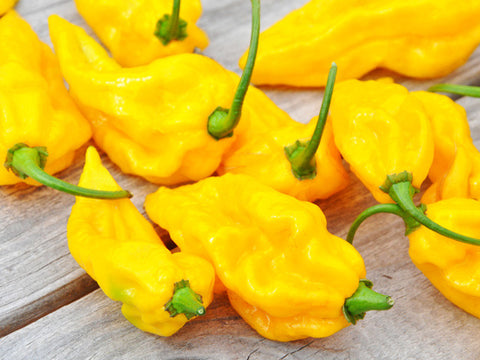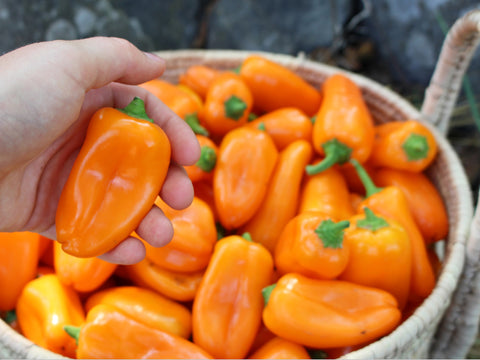Pepper seeds and young plants need a tad more attention than their more forgiving relative, the tomato. Dive into the world of indoor pepper seeding and be amazed by the variety of colors, shapes, and flavors!

Pictured: Fatalli Pepper (Click for seeds)
🔆 Key Tips for Pepper Success:
- Bright, Artificial Light: Ensure they're well-lit.
- Quality Soil: Only the best for your peppers!
- Avoid Pot Bounding: Ensure they have enough space.
- Harden Off: Prep them before moving outdoors.
💡 Why Indoors?: In northern climates, start peppers indoors for a good harvest before the chilly fall frosts. Moreover, starting your own seeds means diving into a world full of pepper varieties, not just the standard ones!
⏰ Timing is Everything: Begin 8 weeks before the last spring frost. For those in USDA Zone 5-6 of southeast Michigan, the magic date is around March 15th.

Pictured: Sheepnose Pimento Sweet Pepper (Click for seeds)
🌱 Seed Starting:
-
Supplies:
-
Soil: We swear by Vermont Compost's organic Fort Vee or Fort Lite. Available at Fedco. Make your own soil mix! Click here for a recipe (if you are in southeast Michigan and/or have high pH water, do not add limestone to the soil mix).
-
Container: Minimum size 1-1/2" x 1-1/2" x 2.25" deep.
-
Heating: Peppers love warmth (77° – 90°). We recommend a seed heating mat.
-
-
Steps:
-
Start seeds around March 15th in USDA Zone 5-6.
-
Plant several seeds per container, about ¼” deep.
-
Label each container.
-
Use a heating mat and keep seeds moist but not too wet.
-
After germination, choose the strongest seedling to keep.
-
🌱 Growing Pepper Seedlings:
- Light: Aim for 16 hours/day. Consider T5 fluorescent or High Pressure Sodium lights, and don’t forget a timer.
- Temperature: Maintain between 65-75°F.
- Watering: Moist but not drenched. We love Haws brand watering cans.
- Fertilizing: If you’ve got compost-based soil mix, skip this step. Otherwise, go for fish/seaweed liquid fertilizer weekly.
- Pot Bound Warning: Transplant or move outdoors before they’re too restricted.
🌿 Hardening Off:
Prep your indoor champs for the outdoors. This 1-week process makes your plants resilient against sunlight, wind, and temperature fluctuations. You can pick any of the 3 provided methods, but consistency is key!

Pictured: Lunchbox Orange Sweet Pepper (Click for seeds)
🌱 Planting:
- Location: Full sun with organic compost/fertilizer-amended soil.
- Spacing: 1.5 – 2 feet apart.
- Depth: Plant deeply, leaving only some stem and leaf exposed.
- Labeling & Journaling: Optional, but handy for tracking growth.
🌱 Dive Deep Into Soil:
- Quality Matters: Aim for a mix like peat moss, compost, and perlite. Standard garden soil just won't do in containers.
- Nutrients: Many mixes lack them. Ensure your mix includes compost or organic fertilizer.
- Recommendation: We back Vermont Compost's mixes available from Fedco. Also, try Gardener's Supply for a budget-friendly option.
- DIY: Yes, you can craft your own mix! Find a recipe here.
